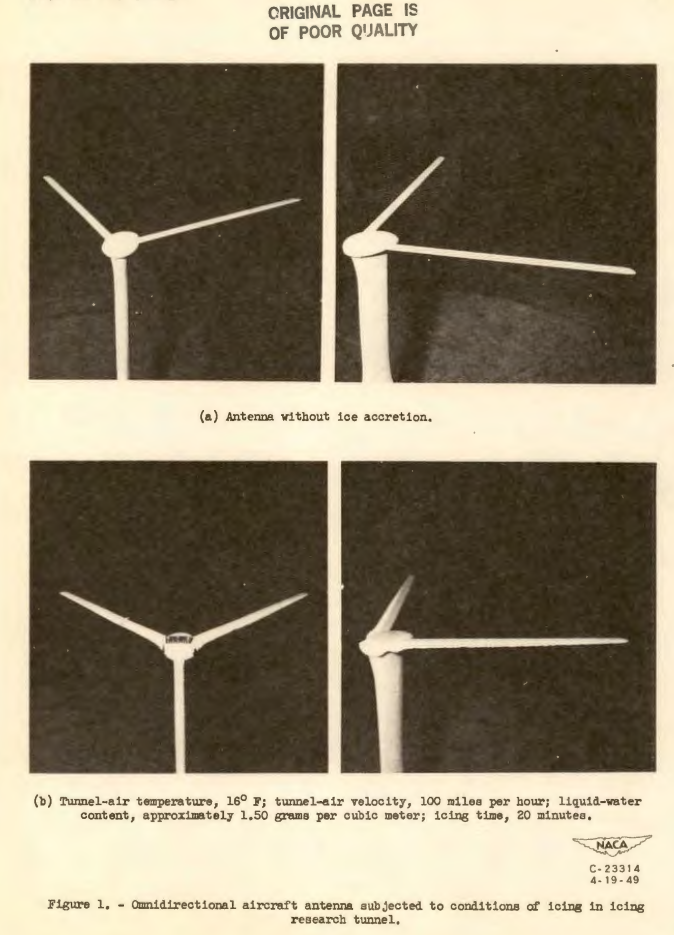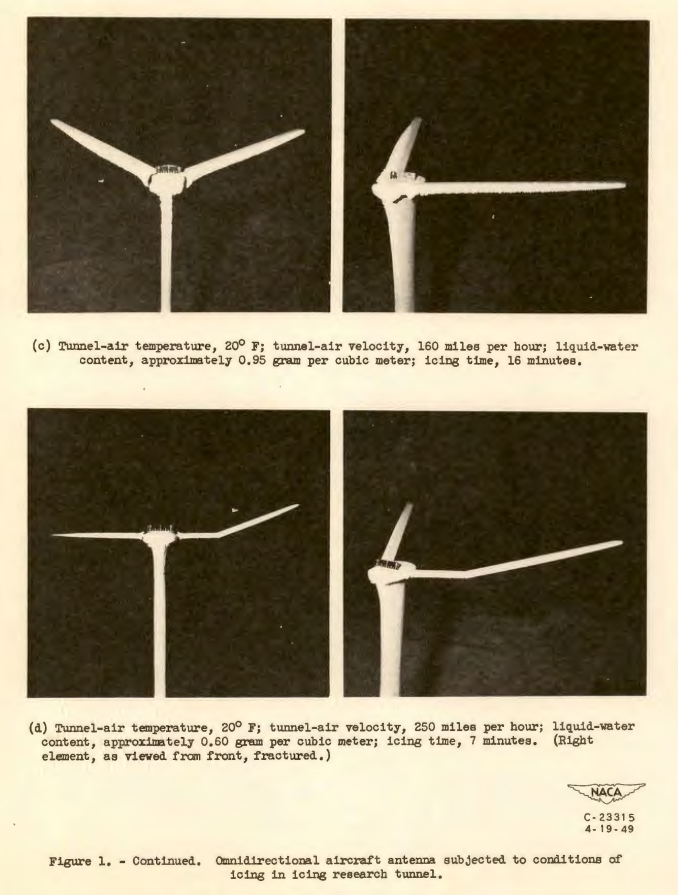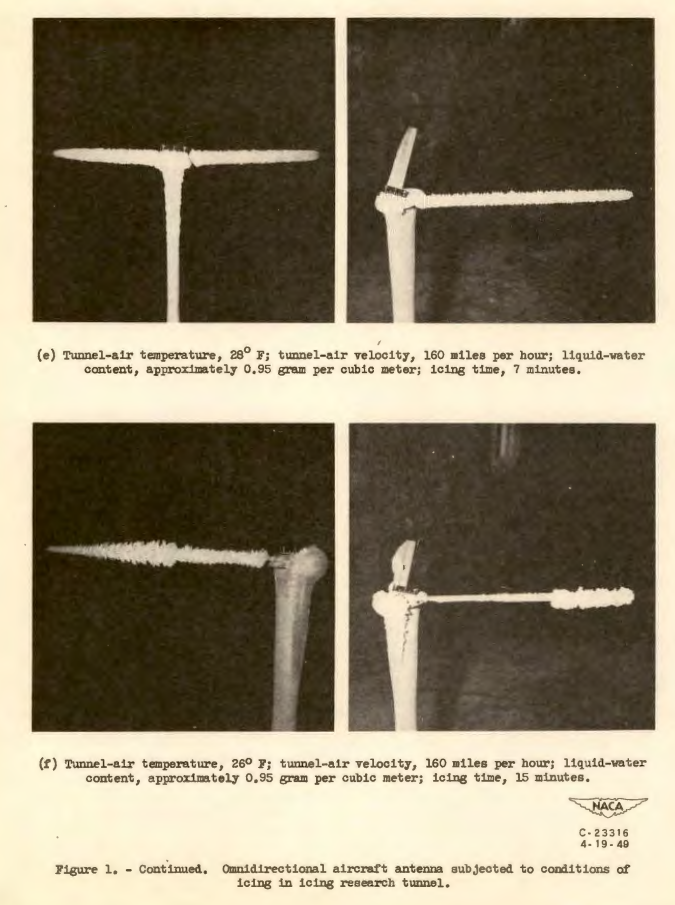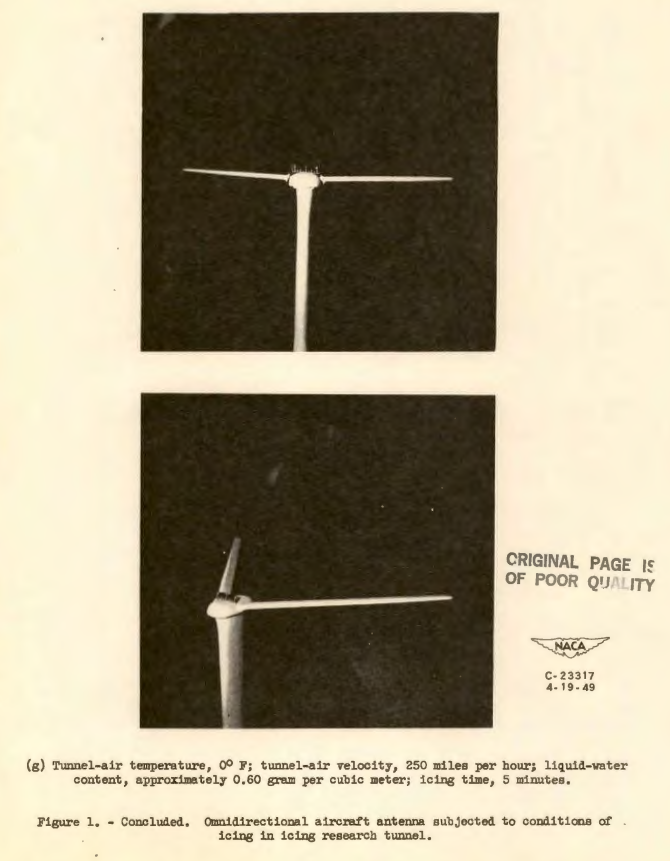"After 7 minutes of icing, however, one antenna element experienced a vibratory failure"
"Vibration and Investigation of CAA Type V-I09 Very-High-Frequency Aircraft Antenna" 1

Abstract
Vibration and icing determinations on a CAA type V-109 very- high-frequency aircraft antenna were conducted in the NACA Lewis icing research tunnel. The antenna is an omnidirectional-range unit that consists of two aluminum elements mounted in a streamline plastic head forming a V in plan view with an apex angle of 80°.
Vibration determinations during a nonicing experiment produced element-tip total amplitude of approximately 1/4 inch at a tunnel-air velocity of 300 miles per hour.
During the icing investigation, a total amplitude as great as 7 inches was observed at the antenna-element tips with tunnel-air velocities greater than 160 miles per hour and a tunnel-air temperature of 20° F. At the higher tunnel-air temperatures, which produced a heavier and more severe ice accretion, the damping effect of the ice reduced the element-tip amplitudes over the entire range of tunnel-air velocities to a maximum of 1/4 inch at a tunnel-air velocity of 300 miles per hour.
Discussion
As this publication is brief (25 pages) it is reproduced almost in its entirety herein.
INTRODUCTION
After experiments with numerous types of directional-range aircraft antenna, the CAA V-109 very-high-frequency antenna was found by the Civil Aeronautics Administration to have improved receiving characteristics when compared with other types of antenna investigated. The CAA V-109 antenna was developed to replace those now being used for four-course low-frequency ranges.
Aerodynamic and icing investigations of the V-109 aircraft antenna. were conducted in the icing research tunnel of the NACA Lewis laboratory at the request of the Civil Aeronautics Administration to determine the flutter or vibration tendencies of the antenna elements under normal flight conditions and the effect of ice formations on the vibration of the antenna.
APPARATUS
The CAA V-109 very-high-frequency aircraft antenna was installed in the 6- by 9-foot test section of the icing research tunnel. A bank of spray nozzles was located upstream of the model to simulate icing conditions.
Each of the antenna elements is made of streamlined aluminum tubing 24-7/8 inches long having a chord of approximately 7/8 inch. The elements are secured in a streamlined laminated plastic head and element cap forming a simple V plan form with an apex angle of 80°. This assembly is mounted on a streamlined aluminum pedestal 18 inches high. Steel inserts approximately 8 inches long are provided adjacent to the head in each of the elements to add strength to the joints. A second antenna used after failure of the first model was the same as the original model except that the element head and cap were made of a transparent solid plastic.
CONDITIONS AND PROCEDURE
A vibration investigation was conducted without icing at tunnel-air velocities of 100, 200, and 300 miles per hour. Icing experiments were conducted at tunnel-air velocities of 100, 160, and 250 miles per hour, and tunnel-air temperatures from 0° to 28° F. The simulated icing cloud for the investigation contained droplets with a mean effective diameter of approximately 11 microns and a liquid-water content of approximately 1.5 grams per cubic meter at a tunnel-air velocity of 100 miles per hour, 0.95 gram per cubic meter at 160 miles per hour, and 0.60 gram per cubic meter at 250 miles per hour. The icing severity and the amplitude of vibration at the tip of the antenna elements were visually determined.
RESULTS AND DISCUSSION
The antenna under icing and nonicing conditions is shown in figure 1.


During the nonicing vibration experiments at tunnel-air velocities of 100, 200, and 300 miles per hour, the amplitude of vibration at the antenna-element tips steadily increased as the tunnel-air velocity increased. An amplitude of approximately 1/4 inch was reached at the element tip at a tunnel-air velocity of 300 miles per hour with a periodic surge of approximately 1/2-inch amplitude. The first part of the icing investigation was conducted at a tunnel-air velocity of 100 miles per hour and a tunnel-air temperature of 16° F. Vibration of the antenna elements began immediately after even very small amounts of ice began to form and reached a maximum total amplitude of approximately 2 inches within 1-1/2 minutes. The antenna after 20 minutes of icing is shown in figure 1(b). At a tunnel-air velocity of 160 miles per hour and a tunnel-air temperature of 20° F, vibration became progressively worse during icing until a total amplitude as great as 6 inches at the element tips was observed within 8 minutes of icing (fig. 1(c)). When the tunnel- air velocity was increased to 250 miles per hour with a tunnel-air temperature of 20° F, the total amplitude was observed to reach approximately 6 inches during the first 3 minutes of icing. Further icing for an additional 4 minutes had little or no effect on the amplitude, which stabilized at approximately 7 inches. After 7 minutes of icing, however, one antenna element experienced a vibratory failure at the end point of the steel insert (figs. 1(d) and 2).

A duplicate investigation was made with a second antenna. having a transparent plastic head to compare its behavior with that of the first antenna. For a nonicing condition, the vibration of the elements was of the same magnitude as for the original. The antenna was subjected to more severe icing at a tunnel-air velocity of 160 miles per hour and a tunnel-air temperature of 28° F. An element-tip amplitude of approximately 6 inches was reached after 4 minutes of icing, but, after 5 minutes of icing, the ice accretion on the antenna elements became so heavy that the damping effect reduced the amplitude to approximately 1/4 inch and further icing for a total of 7 minutes (fig. 1(e)) had no additional effect. Observations were made at 250 and 300 miles per hour with a very heavy ice accretion obtained at 160 miles per hour and 26° F for 15 minutes. The elements with part of the ice shed from the inner sections are shown in figure 1(f). The subsequent observations made at 250 and 300 miles per hour without further icing indicated that vibration (maximum, 1/4 in.) was not serious at these speeds with heavy icing.
At a tunnel-air temperature of 0° F and a tunnel-air velocity of 250 miles per hour, icing was much less severe aerodynamically (fig. 1(g)) and the element-tip vibration amplitude reached approximately 4 inches after 5 minutes of icing.


Conclusions
The following results were obtained from an icing and vibration investigation conducted in the NACA Lewis icing research tunnel using a CAA V-109 very-high-frequency aircraft antenna:
1. During the nonicing vibration investigation at tunnel-air velocities of 100, 200, and 300 miles per hour, the element-tip amplitudes increased in proportion with the velocities and reached a maximum total amplitude of 1/4 inch at a tunnel-air velocity of 300 miles per hour. A surge of approximately 1/2-inch amplitude occurred periodically at a tunnel-air velocity of 300 miles per hour.
2. At a tunnel-air velocity of 100 miles per hour and a tunnel-air temperature of 16° F, total tip amplitudes of not more than 2 inches were observed during a 20-minute icing period. For tunnel-air velocities above 160 miles per hour, vibration amplitudes of 7 inches were realized for icing conditions of a-minute duration or leas. The tunnel-air temperature was maintained at 20° F.
3. Failure of an antenna element occurred after a 7-minute icing period at a tunnel-air velocity of 250 miles per hour and a tunnel-air temperature of 20° F. At the time of failure, tip amplitudes of approximately 7 inches were observed.
4. With more severe icing accumulations, where ice occurred at a tunnel-air temperature of 26° F, the damping effect of the ice at 300 miles per hour reduced the element-tip amplitudes to a maximum of 1/4 inch.
NACA-RM-SE9D20 is unique in that it is one of the few of hundreds of NACA publications that has the author's signature:

Citations
NACA-RM-SE9D20 had no citations, per scholar.google.com.
Notes:
-
Gowan, W. H., Jr.: Vibration and Investigation of CAA Type V-I09 Very-High-Frequency Aircraft Antenna. NACA-RM-SE9D20. 1949. ntrs.nasa.gov ↩